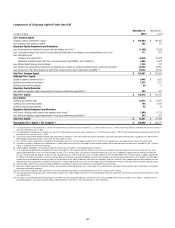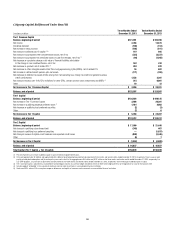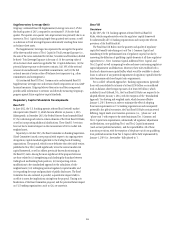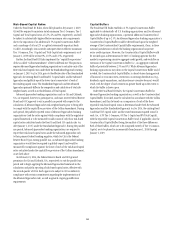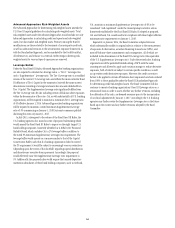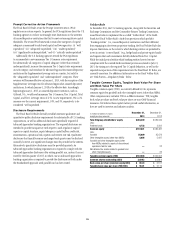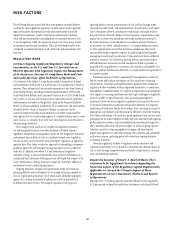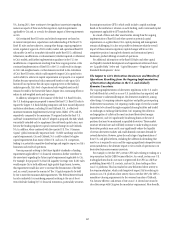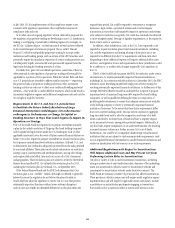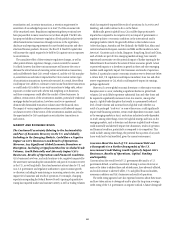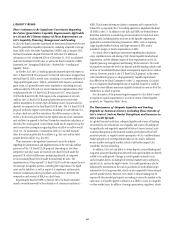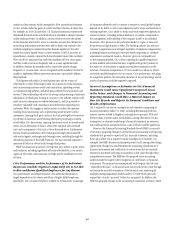Citibank 2013 Annual Report Download - page 76
Download and view the complete annual report
Please find page 76 of the 2013 Citibank annual report below. You can navigate through the pages in the report by either clicking on the pages listed below, or by using the keyword search tool below to find specific information within the annual report.58
under the CFTC’s cross-border guidance, overseas clients who transact their
derivatives business with overseas branches of U.S. banks, including Citi,
could be subject to additional U.S. registration and derivatives requirements,
and these clients have expressed an unwillingness to continue to deal with
overseas branches of U.S. banks as a result. These and similar issues could
disproportionately impact Citi given its global footprint.
Further, the European Union continues to finalize its European Market
Infrastructure Regulation which would require, among other things,
information on all European derivatives transactions be reported to trade
repositories and certain counterparties to clear “standardized” derivatives
contracts through central counterparties. Regulators in Asia also continue
to finalize their derivatives reforms which, to date, have taken a different
approach as compared to the EU or the U.S. Most of these non-U.S. reforms
will take effect after the reforms in the U.S. and, as a result, it is uncertain to
what extent the non-U.S. reforms will impose different, additional or even
inconsistent requirements on Citi’s derivatives activities.
The Dodd-Frank Act also contains a so-called “push-out” provision that,
to date, has generally been interpreted to prevent FDIC-insured depository
institutions from dealing in certain equity, commodity and credit-
related derivatives. The ultimate scope of this provision and its potential
consequences are not certain as rulemaking has not yet been completed.
While this push-out provision was to be effective July 2013, U.S. regulators
were permitted to grant up to an initial two-year transition period to affected
depository institutions, and in June 2013, Citi, like other U.S. depository
institutions, received approval for an initial two-year transition period for
Citibank, N.A., its primary insured depository institution.
Citi currently conducts a substantial portion of its derivatives-dealing
activities within and outside the U.S. through Citibank, N.A. The costs of
revising customer relationships and modifying the organizational structure
of Citi’s businesses or the subsidiaries engaged in these businesses, and
the reaction of Citi’s clients to the potential bifurcation of their derivatives
portfolios between Citibank, N.A. and another Citi affiliate for pushed-out
derivatives, remain unknown. To the extent that certain of Citi’s competitors
already conduct these derivatives activities outside of FDIC-insured depository
institutions, Citi would be disproportionately impacted by any required
restructuring. Moreover, the extent to which Citi’s non-U.S. operations will be
impacted by the push-out provision remains unclear, and it is possible that
Citi could lose market share in its derivatives business or client relationships
in jurisdictions where foreign bank competitors can operate without the same
constraints.
While the implementation and effectiveness of individual derivatives
reforms may not in every case be significant, the cumulative impact of these
reforms is uncertain and could be material to Citi’s results of operations and
competitiveness in these businesses.
In addition, numerous aspects of the new derivatives regime require
extensive compliance systems and processes to be put in place and
maintained, including electronic recordkeeping, real-time public transaction
reporting and external business conduct requirements (e.g., required
swap counterparty disclosures). These requirements have necessitated
the installation of extensive technological, operational and compliance
infrastructure, and Citi’s failure to effectively maintain such systems could
subject it to increased compliance costs and regulatory and reputational
risks. Moreover, these new derivatives-related systems and infrastructure
will likely become the basis on which institutions such as Citi compete for
clients. To the extent that Citi’s connectivity, product offerings or services
for clients in these businesses is deficient, this could negatively impact Citi’s
competitiveness and results of operations in these businesses.
It Is Uncertain What Impact the Restrictions on Proprietary
Trading Activities under the Volcker Rule Will Have on
Citi’s Global Market-Making Businesses and Results
of Operations, and Implementation of the Final Rules
Subjects Citi to Compliance Risks and Costs.
The “Volcker Rule” provisions of the Dodd-Frank Act are intended in part
to prohibit the proprietary trading activities of institutions such as Citi. On
December 10, 2013, the five regulatory agencies required to adopt rules
to implement the Volcker Rule adopted a final rule. Although the rules
implementing the Volcker Rule have been finalized, and the conformance
period has been extended to July 2015, the final rules will require extensive
regulatory interpretation and supervisory oversight, including coordination
of this interpretive guidance and oversight among the five regulatory
agencies implementing the rules.
As a result, the degree to which Citi’s market-making activities will be
permitted to continue in their current form, and the potential impact to Citi’s
results of operations from these businesses, remains uncertain. In addition,
the final rules and restrictions imposed will affect Citi’s trading activities
globally and, thus, will impact it disproportionately in comparison to foreign
financial institutions that will not be subject to the Volcker Rule with respect
to all of their activities outside of the U.S., further increasing the uncertainty
of the impact to Citi’s results of operations.
While the final rules contain exceptions for market-making,
underwriting, risk-mitigating hedging, and certain transactions on behalf
of customers and activities in certain asset classes, and require that certain
of these activities be designed not to encourage or reward “proprietary risk
taking,” it remains unclear how these exceptions will be interpreted and
administered. Absent further regulatory guidance, Citi is required to make
certain assumptions as to the degree to which Citi’s activities in these areas
will be permitted to continue in their current form. If these assumptions are
not accurate, Citi could be subject to increased compliance risks and costs.
Moreover, the final rules require an extensive compliance regime for the
“permitted” activities under the Volcker Rule, including documentation of
historical trading activities with clients, regulatory reporting, recordkeeping
and similar requirements, with certain of these requirements effective


